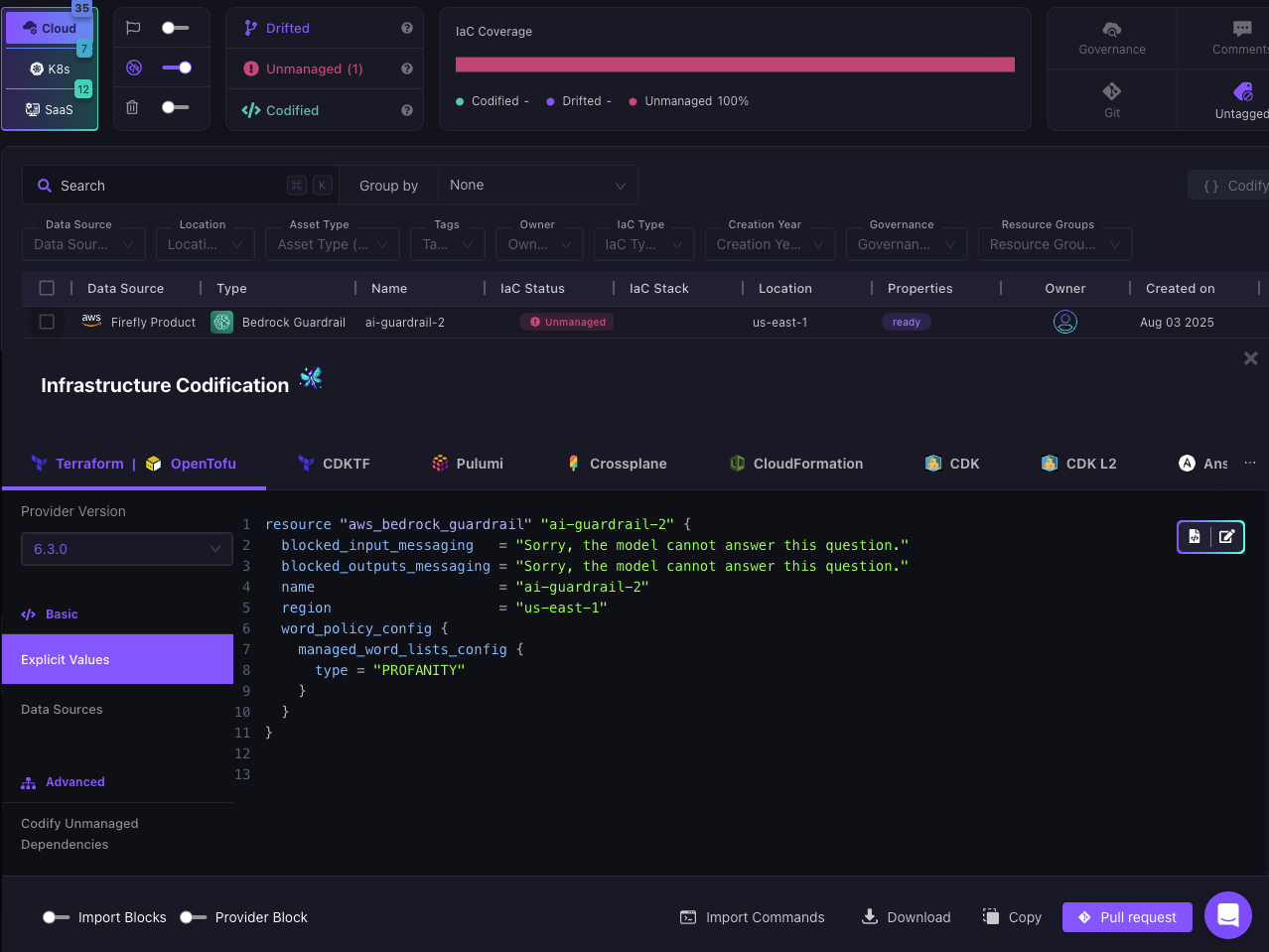The AWS console's sleek interface makes spinning up Bedrock resources feel deceptively simple. A few clicks here, some configuration tweaks there, and suddenly you have a working AI agent complete with knowledge bases and guardrails. But as any seasoned cloud engineer knows, what starts as a quick POC in the console quickly spirals into an unmaintainable nightmare of manual configurations, configuration drift, and audit compliance headaches.
Amazon Bedrock represents the cutting edge of managed AI services, offering everything from foundation model access to sophisticated agents and knowledge bases. Yet many organizations treat their AI infrastructure like a science experiment, manually configuring critical production systems through ClickOps while their traditional infrastructure lives safely in Terraform. This disconnect isn't just operationally risky; it's strategically dangerous.
The Hidden Complexity of AI Infrastructure
Bedrock's apparent simplicity masks significant underlying complexity. A typical production AI application involves interconnected resources spanning multiple AWS services:
- Foundation Models and Custom Models requiring careful versioning and access controls
- Bedrock Agents with complex instruction sets, action groups, and API schemas
- Knowledge Bases integrating with vector stores, S3 buckets, and data sources
- Guardrails implementing content filters, topic restrictions, and PII detection
- IAM roles and policies managing fine-grained permissions across services
- VPC endpoints ensuring secure, private communication
Each component carries configuration dependencies that multiply exponentially. A knowledge base depends on an OpenSearch Serverless collection, which requires specific IAM roles, which need policies referencing S3 buckets that must exist in particular regions with correct encryption settings. Manual management of these interdependencies is where ClickOps fails spectacularly.
Consider this scenario: Your data science team manually creates a Bedrock agent in the console for a customer service chatbot. They configure it with a knowledge base pointing to company documentation in S3, add some guardrails to filter sensitive information, and deploy it successfully. Three months later, someone "temporarily" modifies the agent's instructions during a customer escalation. A week after that, the knowledge base data source gets updated manually to include new documentation. Six months later, you need to recreate this setup in a new region for compliance reasons, except nobody remembers the exact configuration, the original creator has left the company, and the console doesn't export the complete setup.
This isn't hypothetical. This is happening right now in organizations treating AI infrastructure as an afterthought to their IaC strategy.
Why Terraform Changes Everything for AI Workloads
Reproducibility Across Environments
AI applications require consistent environments more than traditional workloads. Model behavior can be subtly affected by configuration differences, making reproducibility critical for debugging and performance analysis. With Terraform, you can ensure your development, staging, and production Bedrock agents have identical configurations:
This approach eliminates environment-specific bugs that plague manually configured AI systems. When your production agent behaves differently than staging, you can confidently rule out configuration drift as the culprit.
Version Control for AI Logic
Your AI agent's instructions and configurations are business logic; they should be treated with the same rigor as application code. Terraform enables true version control for AI infrastructure, allowing you to:
- Track exactly when and why agent instructions changed
- Implement code review processes for AI behavior modifications
- Roll back to previous configurations when new instructions cause issues
- Audit who modified which guardrail policies and when
This is particularly crucial for regulated industries where AI decision-making must be auditable and explainable.
Automated Guardrail Management
Guardrails represent your organization's AI safety and compliance policies; they're far too critical to manage manually. Terraform allows you to codify these policies and ensure consistent application:
When compliance requirements change or new risks emerge, you can update guardrail policies through your standard change management process rather than scrambling to manually update configurations across multiple environments.
Knowledge Base Management at Scale
Knowledge bases are particularly susceptible to configuration drift. Data sources change, vector store configurations evolve, and embedding models get updated. Terraform provides the orchestration layer to manage these changes systematically:
This infrastructure-as-code approach ensures that knowledge base updates are coordinated, tested, and reversible; critical capabilities when your AI system's knowledge directly impacts business outcomes.
The Real Cost of ClickOps in AI Systems
Security and Compliance Nightmares
AI systems process sensitive data and make consequential decisions. Manual configuration of security controls creates gaps that auditors love to find. Consider these common ClickOps-induced security issues:
- Inconsistent IAM policies: Manually created roles often have overly broad permissions because engineers grant access liberally to "make things work"
- Missing encryption: Forgetting to enable encryption on S3 buckets storing training data or model artifacts
- Unmonitored access: No systematic logging of who accessed which AI models or modified which configurations
- Guardrail bypass: Manual modifications that accidentally disable content filtering or PII protection
Terraform enforces security best practices through code review and automated validation, making it nearly impossible to accidentally deploy insecure configurations.
Operational Fragility
AI workloads are inherently complex, and ClickOps adds unnecessary fragility:
Dependency Hell: Manually managing the intricate dependencies between Bedrock resources, IAM roles, S3 buckets, and VPC configurations leads to brittle systems that break when any component changes.
Knowledge Silos: The person who manually configured your production AI agent becomes a single point of failure. When they leave or forget the configuration details, troubleshooting becomes archaeological work.
Incident Response Delays: During outages, manual reconfiguration is slow and error-prone. Terraform enables rapid, consistent recovery through infrastructure-as-code.
Hidden Technical Debt
Every manual change creates technical debt that compounds over time:
- Configuration Skew: Production environments gradually diverge from other environments
- Undocumented Changes: Manual modifications that solve immediate problems but create long-term maintenance burdens
- Upgrade Complexity: Model updates and service enhancements become risky when you can't confidently reproduce current configurations
Terraform Best Practices for Bedrock
Modular Design for AI Components
Structure your Terraform code to reflect the logical boundaries of AI workloads:
State Management for AI Workloads
AI infrastructure requires careful state management due to resource dependencies and data sensitivity:
Data Source Integration
Leverage Terraform data sources to maintain consistency with existing infrastructure:
Advanced Patterns for Production AI
Custom Model Management
For organizations fine-tuning foundation models, Terraform provides essential lifecycle management:
Multi-Environment Orchestration
Production AI systems require sophisticated environment management:
The Firefly Advantage? Bridging the ClickOps Gap
Even with the best intentions, ClickOps happens. Emergency fixes, proof-of-concepts that go to production, or temporary workarounds that become permanent. Every organization struggles with the gap between IaC ideals and operational reality.
This is where Firefly becomes invaluable. Instead of fighting the inevitable, Firefly automatically detects when Bedrock resources have been created or modified outside of Terraform and generates the corresponding IaC code to bring them under management.
Imagine discovering that your data science team has manually created a new Bedrock agent in production with custom guardrails and knowledge base integrations. Instead of reverse-engineering the configuration or letting it remain as technical debt, Firefly scans your AWS environment and generates the complete Terraform code:

This capability is transformative for organizations scaling AI operations. Instead of forcing a choice between speed and governance, Firefly enables teams to move fast while automatically maintaining IaC hygiene.
Making the Transition
Assessment and Planning
Start by auditing your current Bedrock infrastructure:
- Inventory existing resources: Document all manually created agents, knowledge bases, and guardrails
- Identify dependencies: Map relationships between Bedrock resources and supporting infrastructure
- Assess complexity: Prioritize migration based on business criticality and configuration complexity
Gradual Migration Strategy
Don't attempt to migrate everything at once. Use this phased approach:
Phase 1: New Resources Only
- Establish Terraform modules for all new Bedrock deployments
- Implement CI/CD pipelines for IaC validation and deployment
- Train teams on Terraform best practices for AI workloads
Phase 2: Critical Production Systems
- Migrate business-critical AI applications to Terraform management
- Implement monitoring and alerting for configuration drift
- Establish backup and disaster recovery procedures
Phase 3: Comprehensive Coverage
- Complete migration of all Bedrock resources
- Implement advanced patterns like automated model lifecycle management
- Integrate with broader infrastructure automation initiatives
Team Enablement
Success requires more than technical implementation:
- Developer Training: Ensure teams understand Terraform patterns specific to AI workloads
- Process Integration: Integrate IaC requirements into existing development workflows
- Cultural Change: Reward IaC adoption and gradually restrict console access for production resources
What’s Next and How to Prepare for the Future of AI Infrastructure
The question isn't whether to adopt IaC for your AI infrastructure; it's how quickly you can make the transition before ClickOps creates irreversible technical debt. With tools like Firefly automatically bridging the gap between manual configurations and infrastructure-as-code, there's no excuse for leaving your AI infrastructure in the dark ages of manual management.
Your AI applications are too important for ClickOps. Your business depends on their reliability, security, and scalability. IaC ensures you can deliver all three while enabling rapid innovation and maintaining the governance standards your organization demands.
Ready to bring your Bedrock infrastructure under proper management? Try Firefly for free and automatically generate Terraform code from your existing Bedrock configurations. Transform months of reverse-engineering work into minutes of automated code generation, and finally bridge the gap between your AI ambitions and infrastructure reality.



